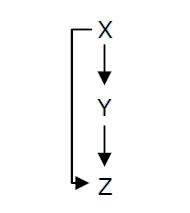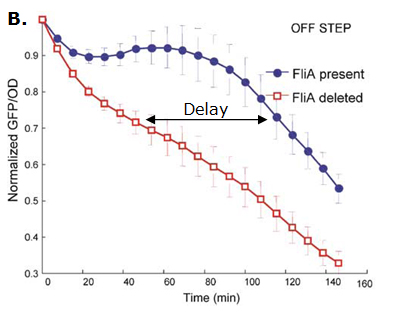Paris/FFL
From 2008.igem.org
| Line 5: | Line 5: | ||
Depending on the type of regulations between the different nodes, we can define eight types of FFL that can be classified into two groups : ''coherent'' and ''incoherent'' FFLs. In ''coherent'' FFLs, the indirect path has the same overall sign as the direct path. The most abundant FFL is the type-1 coherent FFL (C1-FFL) ''(Figure 1)''. | Depending on the type of regulations between the different nodes, we can define eight types of FFL that can be classified into two groups : ''coherent'' and ''incoherent'' FFLs. In ''coherent'' FFLs, the indirect path has the same overall sign as the direct path. The most abundant FFL is the type-1 coherent FFL (C1-FFL) ''(Figure 1)''. | ||
| - | In addition to the signs of the edges, to understand the dynamics of the FFL, we must also know how the inputs from the two regulators X and Y are integrated at the promoter of the gene Z. Uri ALON considers that there are two biologically reasonable logic functions : "AND" logic, in which ''both'' X and Y activities are need to be high in order to turn on Z expression and "OR" logic in which ''either'' X or Y is sufficient ''(Figure 2 | + | In addition to the signs of the edges, to understand the dynamics of the FFL, we must also know how the inputs from the two regulators X and Y are integrated at the promoter of the gene Z. Uri ALON considers that there are two biologically reasonable logic functions : "AND" logic, in which ''both'' X and Y activities are need to be high in order to turn on Z expression and "OR" logic in which ''either'' X or Y is sufficient ''(Figure 2)''. |
| - | If the input function of the promoter of the gene Z is "OR", Z is expressed when X activity is high. There is no delay following the expression of X. But when X is not expressed anymore, its concentration decreases and reach the activation threshold of Y and Z. Y is not expressed anymore but as the concentration decreases, Z is still expressed. '''The OR-gate C1-FFL allow the gene Z to be expressed about one more hour after the gene X is OFF.''' ''(Figure | + | |
| + | |||
| + | |||
| + | [[Image:OR gate.JPG|thumb|center|350px|Fig. 2 : The C1-FFL with OR logic in the flagella system of ''E. coli''.]] | ||
| + | |||
| + | If the input function of the promoter of the gene Z is "OR", Z is expressed when X activity is high. There is no delay following the expression of X. But when X is not expressed anymore, its concentration decreases and reach the activation threshold of Y and Z. Y is not expressed anymore but as the concentration decreases, Z is still expressed. '''The OR-gate C1-FFL allow the gene Z to be expressed about one more hour after the gene X is OFF.''' ''(Figure 3)'' | ||
| + | |||
| + | [[Image:Delay.JPG|thumb|center|250px|Fig. 3 : Promoter dynamics after an OFF step of X, in the presence of Y. The results are shown for the wild-type bacterium, and for a bacterium in which the gene for Fli1 was deleted from the genome. The FFL generates a delay after an OFF step of X]] | ||
Bibliography : | Bibliography : | ||
| - | [http://www.nature.com/ng/journal/v31/n1/abs/ng881.html Shen-Orr ''et al''. (2002)] | + | 1. [http://www.nature.com/ng/journal/v31/n1/abs/ng881.html Shen-Orr ''et al''. (2002)] |
| - | [http://www.ncbi.nlm.nih.gov/pubmed/14607112?ordinalpos=1&itool=EntrezSystem2.PEntrez.Pubmed.Pubmed_ResultsPanel.Pubmed_DefaultReportPanel.Pubmed_RVDocSum Mangan ''et al''. (2003)] | + | 2. [http://www.ncbi.nlm.nih.gov/pubmed/14607112?ordinalpos=1&itool=EntrezSystem2.PEntrez.Pubmed.Pubmed_ResultsPanel.Pubmed_DefaultReportPanel.Pubmed_RVDocSum Mangan ''et al''. (2003)] |
| - | [http://www.ncbi.nlm.nih.gov/pubmed/14530388?ordinalpos=2&itool=EntrezSystem2.PEntrez.Pubmed.Pubmed_ResultsPanel.Pubmed_DefaultReportPanel.Pubmed_RVDocSum Mangan ''et al''. (2003)] | + | 3. [http://www.ncbi.nlm.nih.gov/pubmed/14530388?ordinalpos=2&itool=EntrezSystem2.PEntrez.Pubmed.Pubmed_ResultsPanel.Pubmed_DefaultReportPanel.Pubmed_RVDocSum Mangan ''et al''. (2003)] |
| - | [http://www.pubmedcentral.nih.gov/articlerender.fcgi?tool=pubmed&pubmedid=16729041 Kalir ''et al''. (2005)] | + | 4. [http://www.pubmedcentral.nih.gov/articlerender.fcgi?tool=pubmed&pubmedid=16729041 Kalir ''et al''. (2005)] |
Revision as of 17:46, 25 October 2008
A Feed-Forward Loop is a genetic network composed of three nodes. This strong network motif is composed of a transcription factor X that regulates a second transcription factor, Y, and both X and Y regulate Z (Figure 1).
Depending on the type of regulations between the different nodes, we can define eight types of FFL that can be classified into two groups : coherent and incoherent FFLs. In coherent FFLs, the indirect path has the same overall sign as the direct path. The most abundant FFL is the type-1 coherent FFL (C1-FFL) (Figure 1).
In addition to the signs of the edges, to understand the dynamics of the FFL, we must also know how the inputs from the two regulators X and Y are integrated at the promoter of the gene Z. Uri ALON considers that there are two biologically reasonable logic functions : "AND" logic, in which both X and Y activities are need to be high in order to turn on Z expression and "OR" logic in which either X or Y is sufficient (Figure 2).
If the input function of the promoter of the gene Z is "OR", Z is expressed when X activity is high. There is no delay following the expression of X. But when X is not expressed anymore, its concentration decreases and reach the activation threshold of Y and Z. Y is not expressed anymore but as the concentration decreases, Z is still expressed. The OR-gate C1-FFL allow the gene Z to be expressed about one more hour after the gene X is OFF. (Figure 3)
Bibliography :
 "
"


